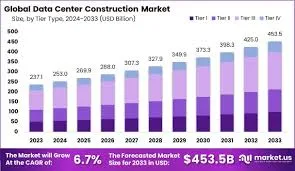
The U.S. data center construction market is experiencing rapid expansion, driven by accelerating digital transformation across nearly every sector of the economy. According to Persistence Market Research, ten key trends are powering this unprecedented growth—from cloud computing and AI to regulatory compliance and green building initiatives.

With data centers serving as the critical infrastructure behind cloud platforms, financial systems, and national security operations, their construction has become a focal point for both private investment and public interest.
Enterprise migration to cloud platforms like AWS, Azure, and Google Cloud is pushing demand for scalable, high-performance data centers. As noted by industry analysts, “These platforms demand robust and scalable data center infrastructure to support dynamic workloads, user traffic, and data security.”
As data-hungry technologies like AI and machine learning enter the mainstream, they are reshaping data center design. “AI-driven applications are forcing tech giants and enterprises to invest heavily in purpose-built data centers,” says the report.
The nationwide rollout of 5G is fueling demand for smaller, regional edge data centers to reduce latency and enable real-time processing for smart cities, IoT, and AR applications.
Companies like Amazon, Walmart, PayPal, and Stripe are investing in backend infrastructure to support soaring digital transactions. “The pandemic-induced shift toward online shopping and digital transactions has significantly increased the demand for secure and scalable data infrastructure.”
Federal initiatives such as FedRAMP are pushing for more compliant, secure, and localized data center builds. “Agencies are leveraging hybrid cloud strategies, creating an ongoing need for highly secure, government-compliant data center construction projects.”
Companies like Google and Meta are targeting carbon-neutral data center operations. As Persistence notes, “Sustainability is now a competitive differentiator,” and LEED certification and renewable energy integration are influencing construction strategies.
SMEs unable to build private facilities are increasingly adopting colocation solutions. These shared environments boost demand for multi-tenant facilities that deliver flexibility without massive capital investments.
Real estate investment trusts and private equity firms are heavily funding data center campuses across key states. This is accelerating both new builds and retrofits in high-demand regions like Virginia and California.
With regulations like HIPAA and CCPA, companies are building data centers that meet location-specific rules. “Companies are constructing region-specific data centers to ensure data remains within certain jurisdictions.”
The shift to hybrid work models and digital collaboration tools is driving long-term IT investment. “Companies allocated larger portions of their IT budgets to cloud services and digital platforms,” fueling demand for infrastructure upgrades.
The convergence of AI, cloud computing, and sustainability is not just shaping data center demand—it’s redefining how facilities are financed, constructed, and operated. Edge computing has added a new layer of complexity, requiring low-latency, high-availability nodes spread across metro and secondary markets.
Meanwhile, hyperscale builds continue to dominate major tech hubs, especially in regions with strong fiber connectivity and access to renewable power sources. States like Texas, Virginia, Georgia, and Arizona have emerged as hotspots due to favorable tax incentives, power grid infrastructure, and proximity to end-users.
Moreover, the role of federal and local government policies cannot be understated. From energy efficiency mandates to broadband expansion grants, public sector efforts are increasingly aligned with the data center boom.
Persistence Market Research emphasizes that as the digital economy evolves, “organizations that align their construction strategies with these emerging trends will be better positioned to meet tomorrow’s digital infrastructure needs.”
The outlook remains strong: whether supporting AI workloads, enabling 5G applications, or securing patient health records, data center construction is now foundational to America’s economic and technological future.
Originally reported by Times Tech.